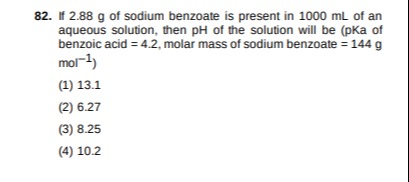Question
Question: If 2.88 g of sodium benzoate is present in 1000 mL of an aqueous solution, then pH of the solution w...
If 2.88 g of sodium benzoate is present in 1000 mL of an aqueous solution, then pH of the solution will be (pKa of benzoic acid = 4.2, molar mass of sodium benzoate = 144 g mol−1)

A
13.1
B
6.27
C
8.25
D
10.2
Answer
8.25
Explanation
Solution
To find the pH of the solution, we need to consider the hydrolysis of sodium benzoate. Here's a step-by-step breakdown:
-
Calculate moles of sodium benzoate:
Moles=144g/mol2.88g=0.02molSince the volume is 1 L, the concentration [A−]=0.02M.
-
Hydrolysis equilibrium of benzoate ion:
A−+H2O⇌HA+OH− -
Determine Kb:
Given pKa=4.2, so
Ka=10−4.2≈6.31×10−5and
Kb=KaKw=6.31×10−51.0×10−14≈1.58×10−10 -
Set up the hydrolysis expression:
Let the change in concentration due to hydrolysis be x. Then, at equilibrium:
Kb=0.02x2 x2=(1.58×10−10)(0.02)=3.16×10−12 x=3.16×10−12≈1.78×10−6MHere, x is the concentration of OH−.
-
Calculate pOH and then pH:
pOH=−log(1.78×10−6)≈5.75 pH=14−pOH=14−5.75=8.25
Therefore, the pH of the solution is approximately 8.25.
